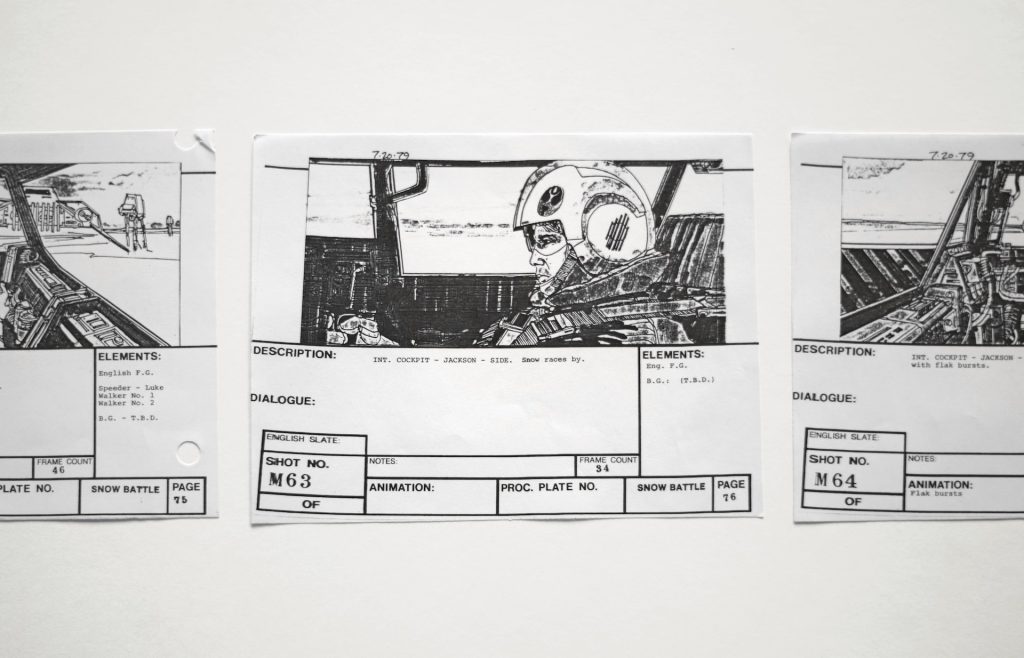A storyboard is typically a series of sequential images designed to be shown as a sequence to outline the content, show exactly what happens, reveal the pace and intent of the scene, and help guide the director in terms of staging.
Quick Links
This is a specialized type of comic strip that tells a story in sequential images. The storyboards are created on paper or over the computer, and the director or editors read them to help them plan how the film will unfold. This guide will show you a storyboard frame and how to create storyboards with no fuss.
What Is A Storyboard Frame?
In filmmaking, storyboarding is the process where artists create comic book-like drawings that detail the action in a movie. Storyboard artists research special effects, props, or lighting that might be needed for a scene, then sketch out how each moment will look. These storyboards become the backbone of the entire film.
A storyboard frame typically features a visual image of whatever you are aiming to accomplish, usually with dialogue bubbles and characters to go along with it. Some storyboards may even feature music cues or other sounds. It’s best to describe your main idea of what you wish to show in each shot.
Steps To Make Your Storyboard In An Easy Way
A storyboard is a great way to start storytelling and gather the thoughts and ideas that lead up to filming a scene. Well, here’s how you do it:
Make A Storyboard Template Online Using Storyboarding Software
First and foremost, you will need a story board creator. This software will allow you to write, edit, and upload your storyboards. If you have been drawing your storyboards previously, then that’s the best place to get the most out of this artwork.
There is a wide variety of options that can be found on your favorite search engine if you do not wish to purchase the software or go through the trouble of downloading it. This is also a good opportunity to practice using noir-type storytelling tools, as it is important to keep in mind what you want viewers to take away from your film after watching it unfold.
Draw Your Storyboard Frames
Once you have selected a piece of software that will work for you, it’s time to start creating the storyboards. You will need to make sure you are drawing on paper, as it is much less messy to erase and redo if done digitally.
Make sure to make your storyboards look as high quality as possible. This is a very important part. If the film crew has trouble reading and understanding what you are trying to portray at any particular moment, they will waste precious time trying to understand this and get back on track. So be sure your images are clear and engaging and try not to be too sloppy.
Edit Your Storyboard
Try to keep the storyboard neat and tidy, as this will make it easier to read and understand. You can even try adding some notes in the margins that detail what it is that you want to show or explain in your frame.
- Choose A Time Of Day – It is essential that you take into consideration what time of day you wish to portray within any given storyboard frame, as this has a direct impact on how everything else will fall into place within your film as a whole, especially if you are aiming for an authentic or realistic feel.
If, for instance, you wish for the camera to move because it is midday and you would like to set a scene in the sun, then be sure that this is conveyed via the storyboard. If you want to show a cloudy day with rain drops falling, then simply paint this during the night. Keep this in mind when creating your storyboard frames.
- Do A Silhouette Check – This is a very important part of creating your storyboards as it will help you to make sure that something may not be included within your frame that viewers can see, which could give any sort of visuals a negative meaning.
- Don’t Upstage Your Character – Make sure you are in control of what you are portraying within each frame, with your character being front and center of these shots. This is a good time to think about the audio as well, as you will want to make sure that there is not too much happening to distract the viewer from what it is you are trying to show.
- Think About Layering – If you are planning on having multiple things going on within one frame, think about how this can be pulled off visually. You will want to ensure that they are not fighting for the viewer’s attention and that they complement each other well. This can be accomplished by using line of sight to lead the viewer’s eyes onto one thing at a time or using color contrast to focus the viewers on one particular element.
The Bottom Line
Now that you have a fairly solid understanding of what storyboards are all about be sure to utilize them whenever possible when starting a new movie project. This will be an excellent way to get a feel for how your movie will play out from start to finish.
For those who want to take this concept one step further, online storyboard creator programs can be used for your movies. These programs allow you to create scene-by-scene storyboards or even the full script to give budget holders an idea of what the film will look like from start to finish. This can also help you visualize how you want the scenes and characters in your movie to come across visually.

